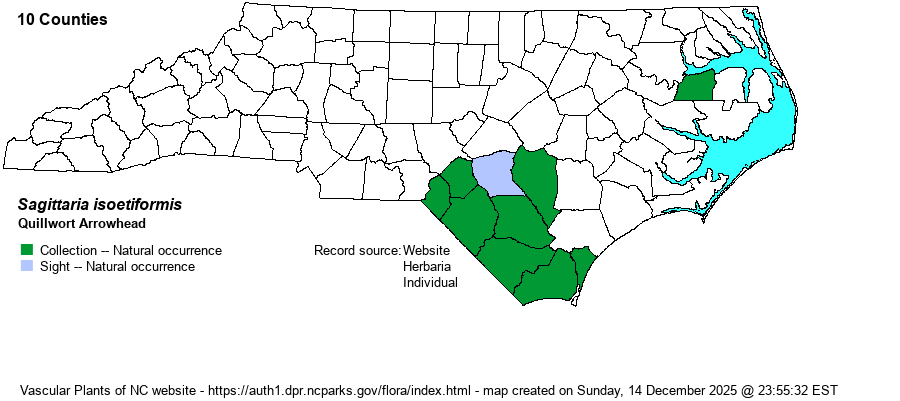| Author | J.G. Smith | |
| Distribution | Present in the southern part of the Coastal Plain, from the Sandhills on the west to New Hanover County on the east. There is an isolated record from Lake Phelps in Washington County. Prior records from Moore and northern Hoke counties prove to be the diminutive S. macrocarpa. A specimen at FSU from the Black River in Pender County actually is S. filiformis (B.A. Sorrie, as determined Jan 2023).
This is a Southeastern Coastal Plain species, found from eastern NC to southern FL and MS. | |
| Abundance | Rare and restricted in habitat in the southern Coastal Plain; very rare in the northern Coastal Plain. This is a State Threatened species. Note that the NCNHP has given this a State Rank of S2, with 14 localities in their database. | |
| Habitat | This species is restricted to shallow water of pools, such as clay-based Carolina bays, margins of bay/natural lakes, various pools and ponds in pinelands, as well as other depressions in acidic soils. It typically blooms in shallow water, with leaves and stem emersed. |
| Phenology | Blooms from June to September, and fruits shortly after blooming. | |
| Identification | This is a slender, grass-like Sagittaria species, even more so than Grassy Arrowhead (S. graminea), as that species does have wider leaf blades than the petioles. In S. isoetiformis, the leaves are like knitting needles and the petiole and blade are usually not distinct. In emergent leaves, the leaves are only 2-3 inches tall and narrowly linear, barely 3-4 mm (about 1/8-inch) wide. These leaves are usually terete (rounded in cross-section), but in submerged plants, the leaves are mostly flattened in cross-section. The very slender flowering stem is also only several inches high, with 2-4 whorls of small white flowers at each whorl. The 3 petals are rather small, and the spread flower is about 2/3-inch across. Though these are not large flowers, in comparison with the tiny nature of the plant, they are rather conspicuously "large". If these plants are not in bloom, surely a biologist would pass them off as a grass or sedge. To see this species, you likely will need to visit a known site, and most known sites are in natural areas (protected or not); most locales are in high-quality wetlands. | |
| Taxonomic Comments | Named as S. teres in RAB (1968) and perhaps some other older references; however, Weakley (1968) says that this latter name was misapplied.
| |
| Other Common Name(s) | None | |
| State Rank | S2 | |
| Global Rank | G3 | |
| State Status | T | |
| US Status | | |
| USACE-agcp | OBL link |
| USACE-emp | OBL link |

